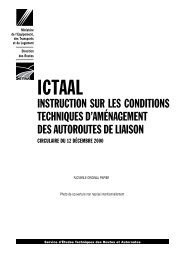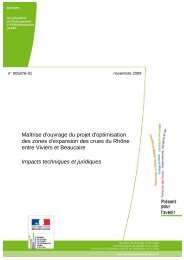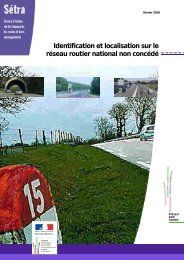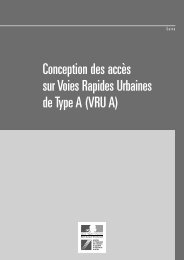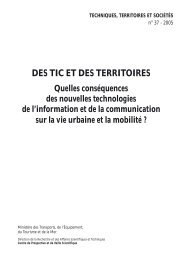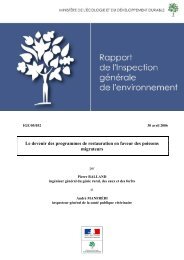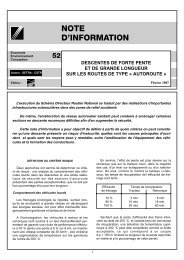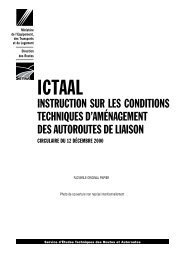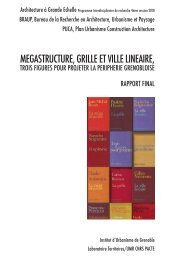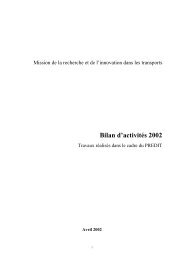Daniel Kaplan - Portail documentaire du Ministère de l'Ecologie
Daniel Kaplan - Portail documentaire du Ministère de l'Ecologie
Daniel Kaplan - Portail documentaire du Ministère de l'Ecologie
You also want an ePaper? Increase the reach of your titles
YUMPU automatically turns print PDFs into web optimized ePapers that Google loves.
268<br />
potential customers. IT also provi<strong>de</strong>s possibilities to<br />
manipulate pictures and, especially in the case of<br />
scenery, strong and indivi<strong>du</strong>ally differing mental<br />
impressions can be created. The other potential<br />
factor is that the Internet provi<strong>de</strong>s textual data<br />
about location, and therefore the Internet is wi<strong>de</strong>ly<br />
used as a new channel for gathering information<br />
before a trip. In fact, via the <strong>de</strong>velopment of new<br />
Internet script-languages (Perl, Java and XML) and<br />
web-browser capabilities to support threedimensional,<br />
interactive and moving objects, has<br />
arisen the i<strong>de</strong>a of virtual travelling, virtual cities and<br />
interactive cities on the WWW. These visualisations,<br />
with interactive features and moving objects<br />
coupled with textual information have challenged<br />
traditional travel gui<strong>de</strong>s and tourist information<br />
leaflets. However, the basic i<strong>de</strong>a of virtual travelling<br />
and speaking of net locations as places seems to be<br />
questionable (see Brey 1998: 253).<br />
In the “travelling” context, the advertisers’ goal<br />
is to get people to travel. There are two types of<br />
instances related to this, and they both have<br />
different, but not exclusive marketing strategies. The<br />
first of these instances is the actual location and its<br />
administration – the city. It seems quite questionable<br />
to think that cities would spend valuable resources in<br />
or<strong>de</strong>r to create the best possible virtual substitute for<br />
their city if there were even a doubt of the possibility<br />
that people would substitute real-world travelling<br />
experience with the electronic counterpart. In<strong>de</strong>ed,<br />
there is no question that at the present moment that<br />
the virtual experience is generally valued more as<br />
bait for the future travel. Several cultural and<br />
sociological studies have been ma<strong>de</strong> on the impacts<br />
of tourism and the Internet and on their effects on<br />
culture, economic activity and political <strong>de</strong>cisionmaking<br />
(Poon 1994; Douglas et al. 1994; Burns<br />
1995).<br />
Secondly, there are IT companies that provi<strong>de</strong><br />
e.g. Internet services and connections are constantly<br />
promoting WWW-travelling via their online<br />
marketing strategies. Taylor comes to the same<br />
conclusion in his article on virtual reality and how<br />
the public knowledge of it is created through<br />
massive advertisement campaigns (Taylor 1997:<br />
176). However, the actual Internet locations and<br />
sites that are visited are irrelevant to the companies.<br />
The only important factor is the use of the<br />
connection provi<strong>de</strong>d by the company. As long as the<br />
connection is continued, it makes no difference<br />
where the customer “surfs”. It seems that the i<strong>de</strong>a of<br />
travelling is one of the easiest ways to persua<strong>de</strong><br />
people to use the Internet. The i<strong>de</strong>a of virtual<br />
travelling “sells”, and that is why it is one of the<br />
leading marketing slogans. For example, companies<br />
like Microsoft, Sonera and Nokia are using these<br />
kinds of themes in their wireless future advertisements.<br />
But as has been argued, once the pro<strong>du</strong>ct is<br />
bought – the travelling i<strong>de</strong>a loses its meaning to the<br />
connection provi<strong>de</strong>r. The i<strong>de</strong>a of transforming<br />
Dr Tommi Inkinen<br />
“travelling” in to the Internet “surfing” is most<br />
questionable.<br />
There are strong differences between different<br />
cities’ image creation via the Internet (e.g. Inkinen<br />
1999). This analysis was done using evaluative and<br />
interpretative methods in or<strong>de</strong>r to explore the<br />
phenomenon of urbanscape and its presentations<br />
on the Internet. It proved to be a useful way to assess<br />
the different aspects of web-site <strong>de</strong>sign in relation to<br />
the real world essence of these locations. The second<br />
theme is related to the dynamic nature of the sites.<br />
Site updating can be seen an important factor in<br />
achieving a competitive advantage. This relates to<br />
the fact that sites are often poorly updated. The<br />
cities usually or<strong>de</strong>r their web-services from the<br />
private sector, and therefore the attitu<strong>de</strong> toward web<br />
advertising is an influential criterion in city’s image<br />
building process. Thirdly, cities are evi<strong>de</strong>ntly using<br />
their Internet pages primarily for two purposes.<br />
Firstly, as an official information source related to<br />
the services, and secondly, as an advertisement to<br />
promote their image to sell the city to a possible<br />
tourist, corporation or citizen. During the three past<br />
<strong>de</strong>ca<strong>de</strong>s, advertising has <strong>de</strong>veloped in a more<br />
visualised direction, away from the textual form<br />
(Fleming and Roth 1991: 290). The escalation of the<br />
Internet can be argued to further that <strong>de</strong>velopment<br />
on the grounds that sites are usually very well<br />
illustrated, and the power that a site has over an<br />
observer <strong>de</strong>pends more on the visual appearance<br />
than on the amount or nature of text inclu<strong>de</strong>d. Also,<br />
the first impression that is provi<strong>de</strong>d through the<br />
visualisation is usually the key factor as to whether<br />
the text will be read at all.<br />
The case of virtual Turku –<br />
representing the city<br />
Description of the case<br />
The composition of the virtual Turku web-site<br />
is diverse. The main function of the site is to provi<strong>de</strong><br />
three-dimensional mo<strong>de</strong>l of the city. The main page<br />
also provi<strong>de</strong>s links to other virtual locations and to<br />
the information sources relevant to the city-mo<strong>de</strong>l.<br />
The information is provi<strong>de</strong>d in Finnish, English and<br />
Swedish.<br />
The project is based on streaming technology<br />
that provi<strong>de</strong>s good tools to represent threedimensional<br />
objects. However, in the interviews,<br />
several technical problems were addressed. They<br />
were related to the technical implementation.<br />
Firstly, the transaction speed of commonly used<br />
<strong>de</strong>vices is ina<strong>de</strong>quate. The most of the Internet<br />
usage is con<strong>du</strong>cted via mo<strong>de</strong>m connections. The<br />
structure is too heavy and absolute time of<br />
downloading the data is too long for most of the



